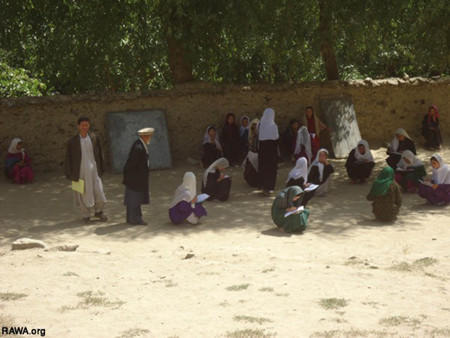by Faird Behbud & Chen Xin

RAWA.org: Despite the flood of billions of dollars as aid in the country, schools in provinces of Afghanistan lack proper furniture, teachers and other important basic facilities. (Photo: RAWA.org)
"We want peace and schooling," said Shah Mirza, an 11-year-old Afghan child, although he was unaware of the International Children's Day which falls on June 1 every year.
Attired in school uniform, Mirza was in a hurry on Thursday morning to reach the classroom on time.
Mirza, the fourth-grader who wanted to become an engineer in the future, was studying in a local school set up by a Non- Governmental Organization (NGO). "My dream is to become an engineer and build houses for my people because I do not want people to live in tents, as we live here in this refugee camp," he said.
Mirza, who lost his father during the Taliban regime, lives with his mother, one brother and two sisters in a tent in Chaman-e- Huzuri camp in the central part of Kabul which houses more than 120 families of Internally Displace Persons (IDPs).
When asked if he knows about the International Children's Day, he said, "I don't know it. What is it like?"
Aschiana, an Afghanistan-based NGO, has been collecting street children and provides shelter, education and vocational courses to them.
"During the Taliban regime (1969-2001), my father was killed in a landmine blast in our village in northern Kabul. Years later, we moved to Kabul city because we lost everything. We don't have any shelter in our village anymore," he said.
Although the Afghan children know little about the International Children's Day, the welfare of the children has been improving gradually in the war-torn country, as nearly 8.4 million children with 39 percent of them girls go to school in Afghanistan today, Afghan Education Minister Farooq Wardak said recently.
However, He said that there are still 4.2 million children with no access to school, mainly due to security reasons and the lack of schools in remote districts across the country.
The on-going Taliban-led insurgency has led to the closure of some 530 schools, mostly in the southern and eastern region where Taliban fighters are active. And according to the Education Ministry, trauma has prevented more than 500,000 children from schooling.
Afghanistan still has a long way to go to recover from the war aftermath and to rebuild educational institutions, thus enabling all Afghan children to get education.
Many children suffering from war and instability in Afghanistan are seen in the capital city Kabul, busily engaged in forced labor including car-washing, shoes-polishing and street vendors.
"I have been forced to join hundreds of children workers in Kabul and to work in a brick factory as a bread earner for my family, because my father is sick," Mohammad Qadir, 17, told Xinhua in a recent interview, adding that his family won't survive if he quit the work.
Mohammad Qadir, whose family has ten members including three older sisters, said that he could earn some 100 to 200 Afghanis (2 to 4 U.S. dollars) daily. "I have no option but to work, to pay off loans taken by my family for basic necessities, and the medical expenses of my father."
The child labor has remained rampant in the brick industry of the war-ravaged Afghanistan, according to a survey by the United Nations International Labour Organization (ILO) in February.
The survey, titled "Buried in Bricks," and aiming to provide an accurate picture of the bonded and child labor in brick factories in two provinces of Afghanistan, Nangarhar and Kabul, said that 56 percent of brick makers in Afghanistan are children under the age of 18, among which 58 percent are boys and 42 percent are girls; while 47 percent are children under the age of 14, among which 33 percent are boys and 14 percent are girls.
"I come to this brick factory at early morning every day. I would love to go to school, to read and write. But I don't have a chance to join school children," said Ahmad Zai, another child labor.
At the same time, Afghan school children also face intimidation and threat by unknown people since the beginning of the educational year in late March, particularly the several toxic gas attacks against schools across the country.
At least eight incidents of poisoning and gas attacks have been registered this year.
Over 120 girls were poisoned on Wednesday in northern Takhar province and over 400 boys were poisoned in eastern Khost province earlier this month.
Ahead of the Children's Day, the UN mission in the country on Thursday called on warring sides to protect civilians especially women and children.
"UNAMA expresses its strong concerns that conflict-related violence continues to kill and injure many Afghan women, men and children throughout the country. 2011 marked the fifth year in a row that civilian casualties increased in the armed conflict in Afghanistan," the UN mission said in a statement.
"UNAMA documented 3,021 civilian deaths in 2011 with 77 percent of all civilian deaths attributed to anti-Government elements and 14 percent to pro-Government forces - Afghan National Security Forces (ANSF) and international forces," it said.
"Conflict-related violence still harms Afghan children, women and men every day across Afghanistan," said Jan Kubis, United Nations Special Representative for the Secretary-General in Afghanistan and head of UNAMA. "Protecting civilians from the consequences of war and preventing civilian casualties should always be the highest priority and strengthened even further during transition of security responsibilities."
The Children's Day has been celebrated in various countries around the globe, but in Afghanistan, the best gift for children is a safe and secure environment for them to grow up.



